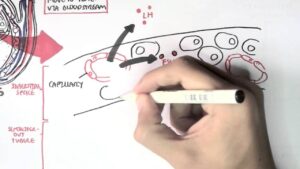LEARN how yoga poses can help you to treat THYROID disorders like like Hypothyroidism & abnormal THYROID levels! Can yoga be helpful for thyroid treatment? One of the most common thyroid diseases is Hypothyroidism, which results from the thyroid gland producing an insufficient amount of thyroid hormone known as thyroxine. Major symptoms of hypothyroidism are fatigue, tremor, nervousness, concentration problems, sweating, increase in bowel movement and rapid weight loss. Thyroid problems are more prevalent with the women especially after the pregnancy or menopause. Hatha Yoga offers several poses to stimulate the thyroid gland & treat hypothyroidism and get rid of thyroid problems in women and men effectively. Here is a list of 5 thyroid exercises you can follow to get rid of hypothyroidism/hyperthyroidism: # Sharvangasana / Shoulder Stand – https://www.youtube.com/watch?v=WKNoV4whglc # Halasana / Plough Pose – https://www.youtube.com/watch?v=hmerP6a8McE # Bhujangasana / Cobra Pose – https://www.youtube.com/watch?v=LK6OqTIqlZs # Dhanurasana / Bow Pose – https://www.youtube.com/watch?v=JUA8TCfUlgw # Ustrasana / Camel Pose – https://www.youtube.com/watch?v=7XcwltuAtz8 Thyroid Disease: The thyroid or endocrine glands consists of two connected lobes. The thyroid gland is found in the neck, below the thyroid cartilage(which forms the Adam’s apple). The thyroid gland controls how quickly the body uses energy, makes proteins, and controls how sensitive the body is to other hormones. It participates in these processes by producing thyroid hormones, the principal ones being triiodothyronine (T3) and thyroxine (sometimes referred to as tetraiodothyronine (T4)). These hormones regulate the growth and rate of function of many other systems in the body. T3 and T4 are synthesized from iodine and tyrosine. The thyroid also produces calcitonin, which plays a role in calcium homeostasis. People can suffer from hyperthyroidism. An overactive thyroid, is defined as an overproduction of the thyroid hormones T3and T4. This condition is most commonly caused by the development of Graves’ disease, an autoimmune disease in which anomalous antibodies stimulate the thyroid to secrete excessive quantities of thyroid hormones.The disease can progress to the formation of a toxic goiter as a result of thyroid growth in response to a lack of negative feedback mechanisms. It presents with symptoms such as a thyroid goiter, protruding eyes (exophthalmo), palpitations, excessive sweating, diarrhea, weight loss, muscle weakness and unusual sensitivity to heat. The appetite is often increased. People can also suffer hypothyroidism. Hypothyroidism is the underproduction of the thyroid hormones T3 and T4. Hypothyroid disorders may occur as a result of # Congenital thyroid abnormalities # Autoimmune disorders such as Hashimoto’s thyroiditis, # Iodine deficiency # The removal of the thyroid following surgery to treat severe hyperthyroidism and/or thyroid cancer. Typical symptoms are abnormal weight gain, tiredness, baldness, cold intolerance, and bradycardia. Hypothyroidism is treated with hormone replacement therapy, such as levothyroxine, which is typically required for the rest of the patient’s life. Yoga for Thyroid Problems: Practicing Yoga for thyroid problems is a natural way to get rid of this medical condition. By practicing yoga regularly, you see normalcy in the production and release of the thyroid hormone. This ensures you reduce the dependency of thyroid medication. However, before starting any physical activity or exercise, always consult a physician. These asanas have been performed by a trained yoga instructor. Music: www.bensound.com http://www.facebook.com/chandrayogindia For more videos on Hatha Yoga Asanas, subscribe to Stylecraze TV @ http://www.youtube.com/stylecrazetv http://www.stylecraze.com/articles/baba-ramdev-yoga-asanas-to-cure-thyroid/ थायराइड योगा, गलग्रंथि, थायराइड समस्या के उपचार, थायराइड के उपचार, थायराइड के लिए योगा

5 Quick Yoga Poses For THYROID Problems & Disorders
- Post author:
- Post published:May 22, 2021
- Post category:Uncategorized
- Post comments:0 Comments
You Might Also Like

General Surgery Video – 1

How often Should I Change My Workout Routine

FRUCTOSE CAN WORSEN THE LIPID PROFILE..

This Full Body Exercise Burns Fat Like Crazy – One Exercise Fat Burning Workout – Sixpack Factory

Barbell Bent Over Row

Bodyweight Tricep Bench Dips

Decline Bench Press-6

How to Stretch Your Triceps (AND HOW NOT TO!)

The Difference Between Sperm & Semen – Episode 20

3 What is injury

What happens inside your body when you get the fever?

Regulation of Insulin Release and Insulin Action

Post Surgery Video – 2

Are Glutamine supplements good?

Pre-Workout PROTEIN Shake Recipe

Lateral Raises-13

5-Minute Workout That Replaces High-Intensity Cardio

Intestinal tuberculosis – Causes, Symptoms | Is intestinal TB contagious? – Dr. Rajasekhar M R

Must have Supplement for Bodybuilders LIV. 52

Anabolic Steroids – History, Definition, Use & Abuse Video – 18

Beginner’s Biceps Training: Perfect the High-Cable Curl Exercise

Special Weight Loss Routine Video – 6

Health Related Fitness Assessment

Deep Water Running | Speedo Fit

What is Fish Oil? Omega-3 Benefits & Side Effects Review by Guru Mann

Male Reproductive System – Hormonal Function and Regulation (sperm synthesis and maturation)

What is BMI? – Understanding Body Mass Index

How to Boost Metabolism and Lose Weight Without Dieting

Step Up-3

Hormones, body mass, and obesity

Sports Physiotherapy Video – 3

Volleyball Video – 2

Dumbbell Pullover-4

Organ Transplantation Surgeries Video – 5
![Read more about the article [NEW] The Best of Amino Acid Supplements | L-Arginine Bodybuilding REVIEW](https://videos.drmaheshkumar.com/wp-content/uploads/2021/05/NEW-The-Best-of-Amino-Acid-Supplements-L-Arginine-Bodybuilding-REVIEW-300x225.jpg)
[NEW] The Best of Amino Acid Supplements | L-Arginine Bodybuilding REVIEW
Erectile Dysfunction Tadaiafil Citrate

Blood Pooling in Hand

Sailing Video – 4

Fat Loss & Obesity

One arm cable triceps extension – Triceps workout / Exercício para Braços – Tríceps

‼️URGENT These SIGNS Indicate That You Have DIABETES‼️

